jacking DODGE SPRINTER 2004 1.G Owners Manual
[x] Cancel search | Manufacturer: DODGE, Model Year: 2004, Model line: SPRINTER, Model: DODGE SPRINTER 2004 1.GPages: 272, PDF Size: 22.71 MB
Page 188 of 272
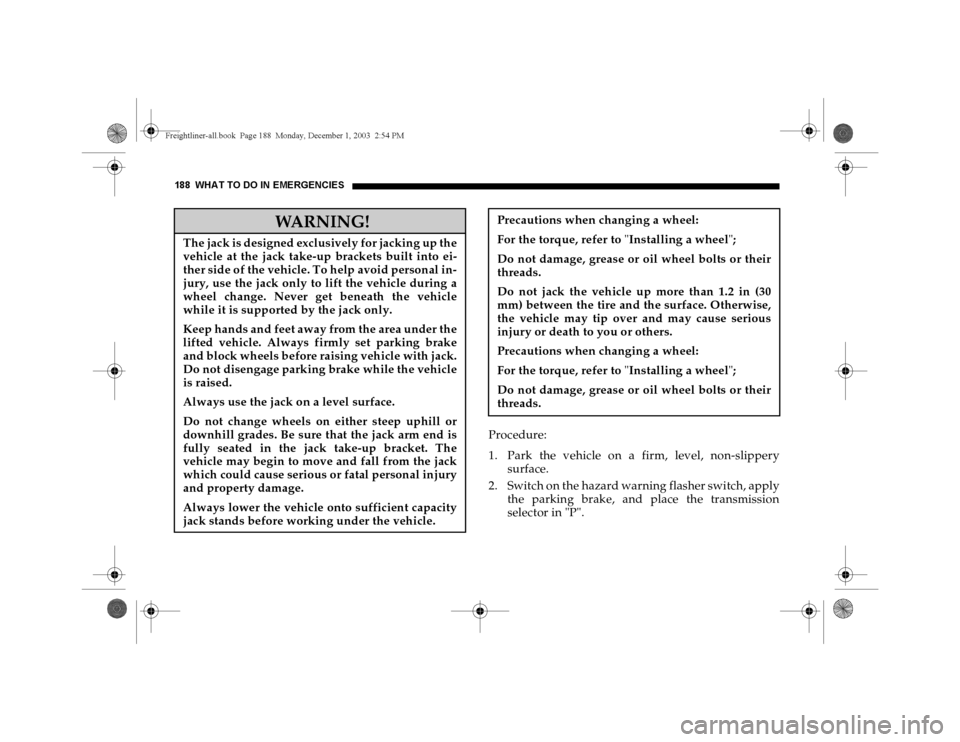
188 WHAT TO DO IN EMERGENCIES
Procedure:
1. Park the vehicle on a firm, level, non-slippery
surface.
2. Switch on the hazard warning flasher switch, apply
the parking brake, and place the transmission
selector in "P".
WARNING!
The jack is designed exclusively for jacking up the
vehicle at the jack take-up brackets built into ei-
ther side of the vehicle. To help avoid personal in-
jury, use the jack only to lift the vehicle during a
wheel change. Never get beneath the vehicle
while it is supported by the jack only.
Keep hands and feet away from the area under the
lifted vehicle. Always firmly set parking brake
and block wheels before raising vehicle with jack.
Do not disengage parking brake while the vehicle
is raised.
Always use the jack on a level surface.
Do not change wheels on either steep uphill or
downhill grades. Be sure that the jack arm end is
fully seated in the jack take-up bracket. The
vehicle may begin to move and fall from the jack
which could cause serious or fatal personal injury
and property damage.
Always lower the vehicle onto sufficient capacity
jack stands before working under the vehicle.
Precautions when changing a wheel:
For the torque, refer to "Installing a wheel";
Do not damage, grease or oil wheel bolts or their
threads.
Do not jack the vehicle up more than 1.2 in (30
mm) between the tire and the surface. Otherwise,
the vehicle may tip over and may cause serious
injury or death to you or others.
Precautions when changing a wheel:
For the torque, refer to "Installing a wheel";
Do not damage, grease or oil wheel bolts or their
threads.
Freightliner-all.book Pag e 188 Monday, December 1, 2003 2:54 PM
Page 189 of 272
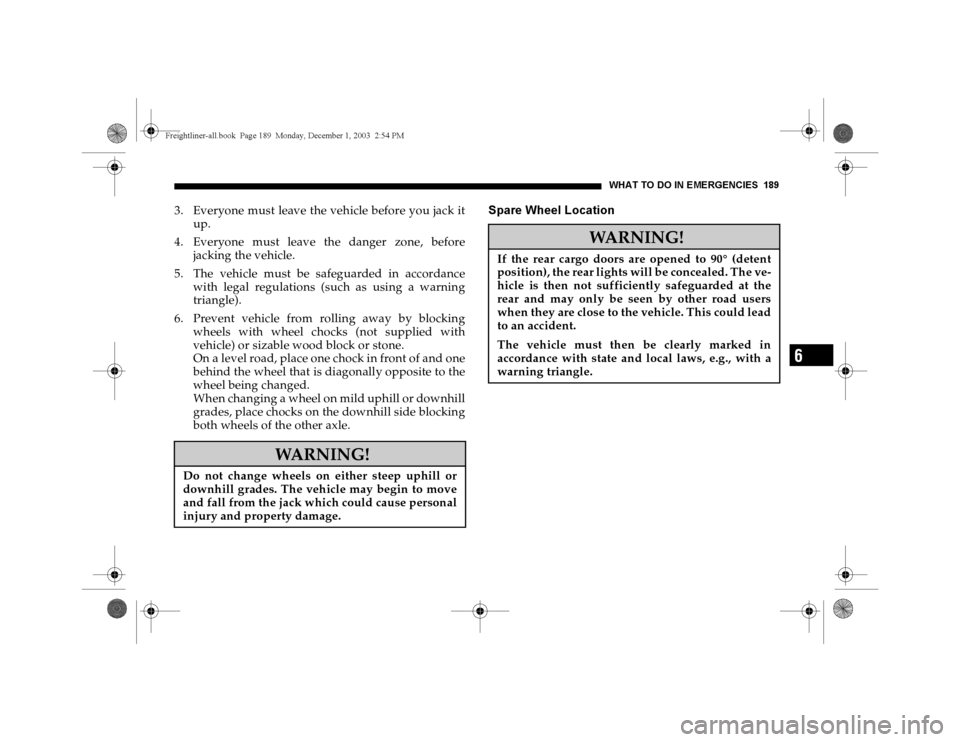
WHAT TO DO IN EMERGENCIES 189
6
3. Everyone must leave the vehicle before you jack it
up.
4. Everyone must leave the danger zone, before
jacking the vehicle.
5. The vehicle must be safeguarded in accordance
with legal regulations (such as using a warning
triangle).
6. Prevent vehicle from rolling away by blocking
wheels with wheel chocks (not supplied with
vehicle) or sizable wood block or stone.
On a level road, place one chock in front of and one
behind the wheel that is diagonally opposite to the
wheel being changed.
When changing a wheel on mild uphill or downhill
grades, place chocks on the downhill side blocking
both wheels of the other axle.
Spare Wheel Location
WARNING!
Do not change wheels on either steep uphill or
downhill grades. The vehicle may begin to move
and fall from the jack which could cause personal
injury and property damage.
WARNING!
If the rear cargo doors are opened to 90° (detent
position), the rear lights will be concealed. The ve-
hicle is then not sufficiently safeguarded at the
rear and may only be seen by other road users
when they are close to the vehicle. This could lead
to an accident.
The vehicle must then be clearly marked in
accordance with state and local laws, e.g., with a
warning triangle.
Freightliner-all.book Pag e 189 Monday, December 1, 2003 2:54 PM
Page 192 of 272
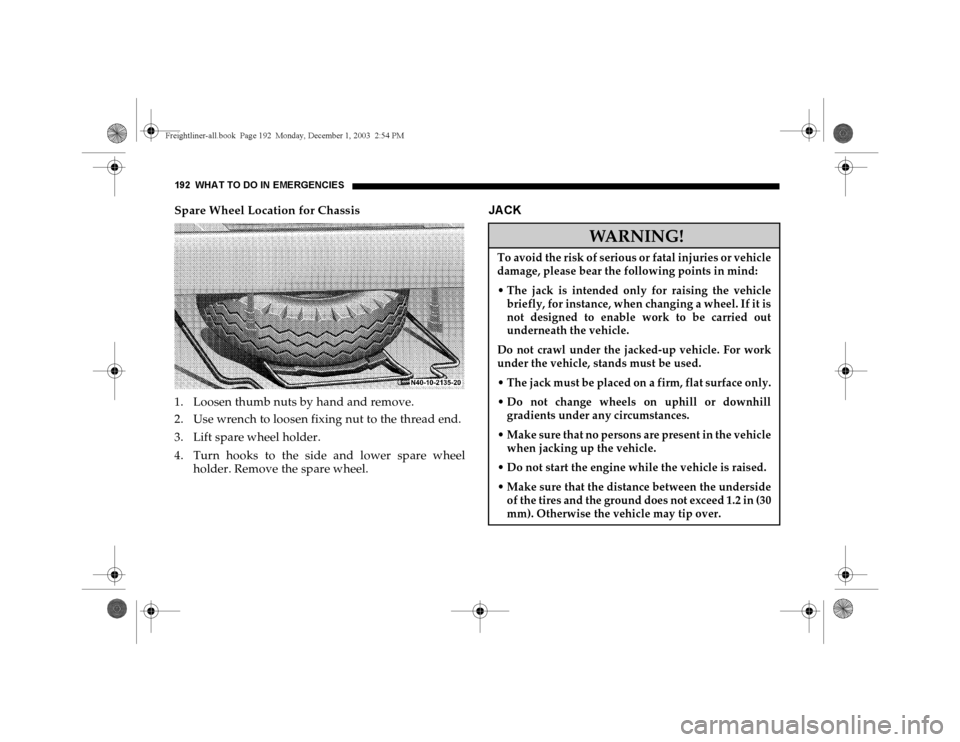
192 WHAT TO DO IN EMERGENCIESSpare Wheel Location for Chassis
1. Loosen thumb nuts by hand and remove.
2. Use wrench to loosen fixing nut to the thread end.
3. Lift spare wheel holder.
4. Turn hooks to the side and lower spare wheel
holder. Remove the spare wheel.
JA CK
WARNING!
To avoid the risk of serious or fatal injuries or vehicle
damage, please bear the following points in mind:
The jack is intended only for raising the vehicle
briefly, for instance, when changing a wheel. If it is
not designed to enable work to be carried out
underneath the vehicle.
Do not crawl under the jacked-up vehicle. For work
under the vehicle, stands must be used.
The jack must be placed on a firm, flat surface only.
Do not change wheels on uphill or downhill
gradients under any circumstances.
Make sure that no persons are present in the vehicle
when jacking up the vehicle.
Do not start the engine while the vehicle is raised.
Make sure that the distance between the underside
of the tires and the ground does not exceed 1.2 in (30
mm). Otherwise the vehicle may tip over.
Freightliner-all.book Pag e 192 Monday, December 1, 2003 2:54 PM
Page 193 of 272
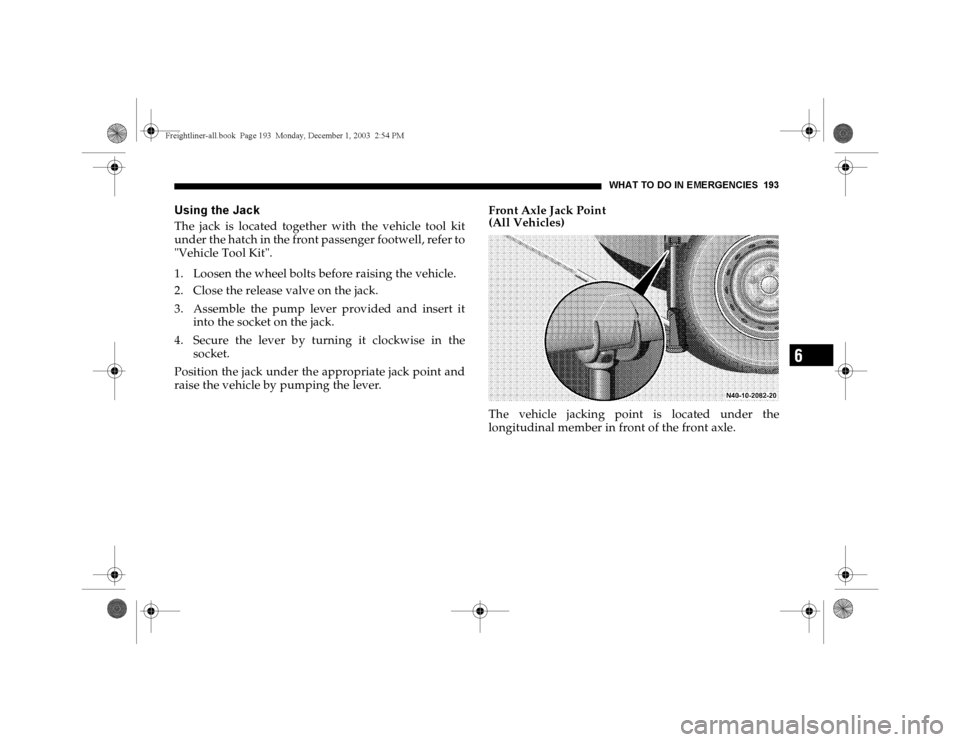
WHAT TO DO IN EMERGENCIES 193
6
Using the JackThe jack is located together with the vehicle tool kit
under the hatch in the front passenger footwell, refer to
"Vehicle Tool Kit".
1. Loosen the wheel bolts before raising the vehicle.
2. Close the release valve on the jack.
3. Assemble the pump lever provided and insert it
into the socket on the jack.
4. Secure the lever by turning it clockwise in the
socket.
Position the jack under the appropriate jack point and
raise the vehicle by pumping the lever.Front Axle Jack Point
(All Vehicles)
The vehicle jacking point is located under the
longitudinal member in front of the front axle.Freightliner-all.book Pag e 193 Monday, December 1, 2003 2:54 PM
Page 194 of 272
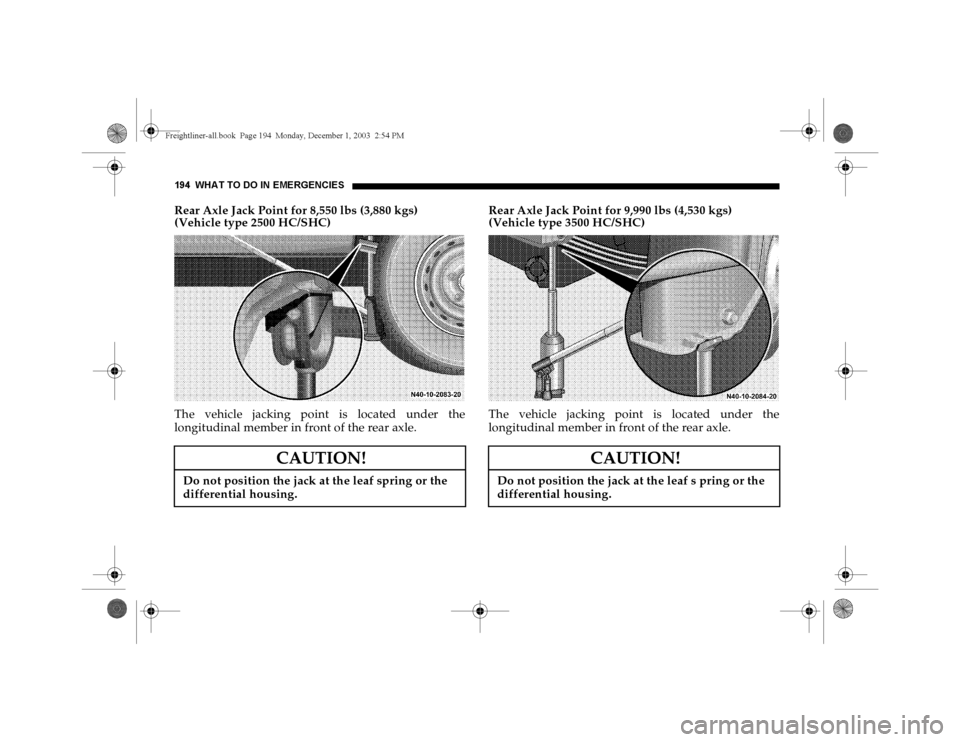
194 WHAT TO DO IN EMERGENCIESRear Axle Jack Point for 8,550 lbs (3,880 kgs)
(Vehicle type 2500 HC/SHC)
The vehicle jacking point is located under the
longitudinal member in front of the rear axle.Rear Axle Jack Point for 9,990 lbs (4,530 kgs)
(Vehicle type 3500 HC/SHC)
The vehicle jacking point is located under the
longitudinal member in front of the rear axle.
CAUTION!
Do not position the jack at the leaf spring or the
differential housing.
CAUTION!
Do not position the jack at the leaf s pring or the
differential housing.
Freightliner-all.book Pag e 194 Monday, December 1, 2003 2:54 PM
Page 195 of 272
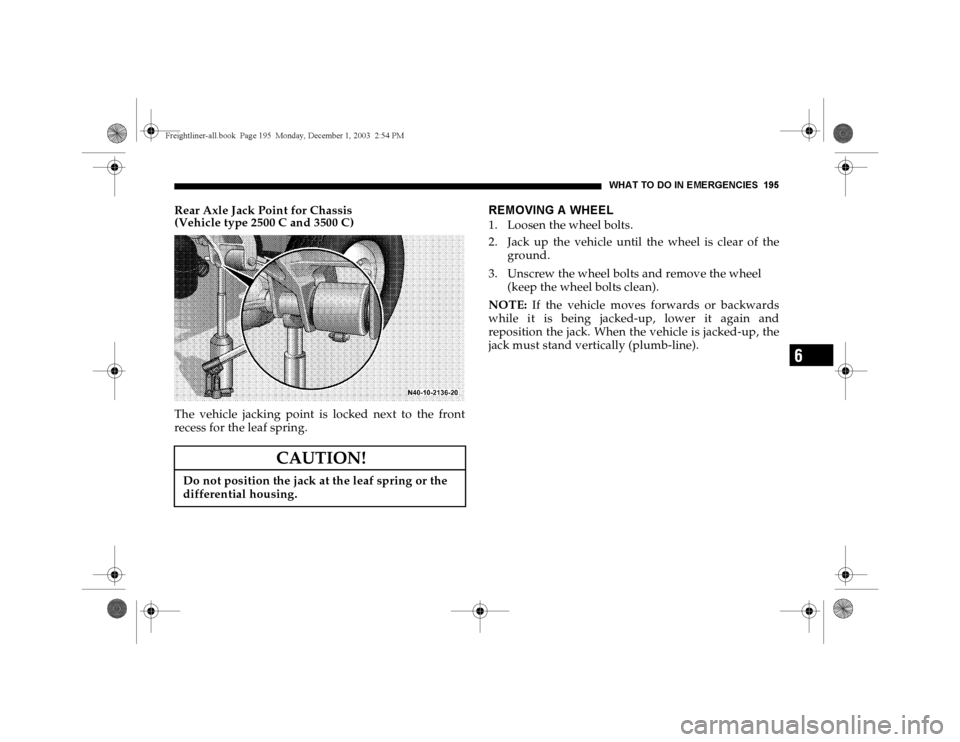
WHAT TO DO IN EMERGENCIES 195
6
Rear Axle Jack Point for Chassis
(Vehicle type 2500 C and 3500 C)
The vehicle jacking point is locked next to the front
recess for the leaf spring.
REMOVING A WHEEL1. Loosen the wheel bolts.
2. Jack up the vehicle until the wheel is clear of the
ground.
3. Unscrew the wheel bolts and remove the wheel
(keep the wheel bolts clean).
NOTE: If the vehicle moves forwards or backwards
while it is being jacked-up, lower it again and
reposition the jack. When the vehicle is jacked-up, the
jack must stand vertically (plumb-line).
CAUTION!
Do not position the jack at the leaf spring or the
differential housing.
Freightliner-all.book Pag e 195 Monday, December 1, 2003 2:54 PM